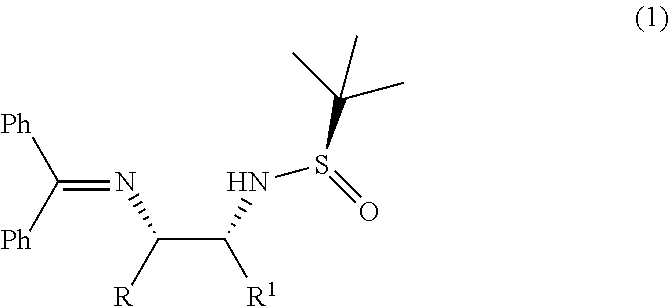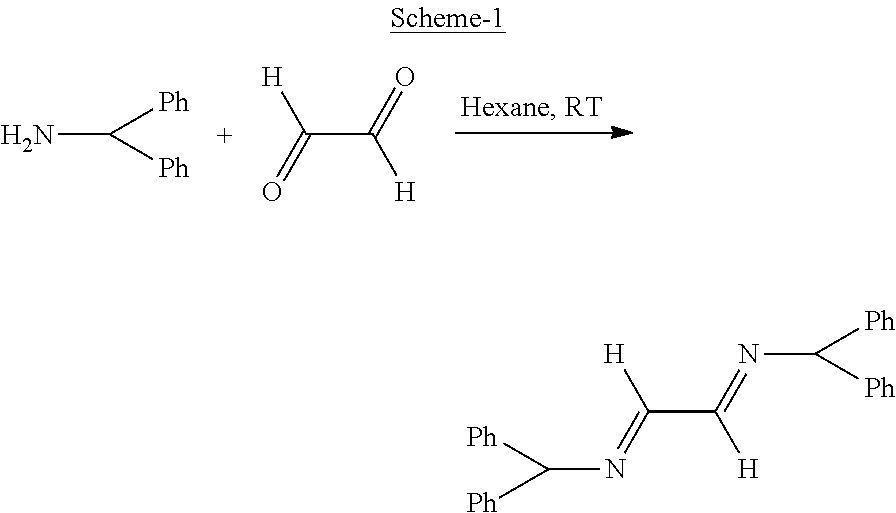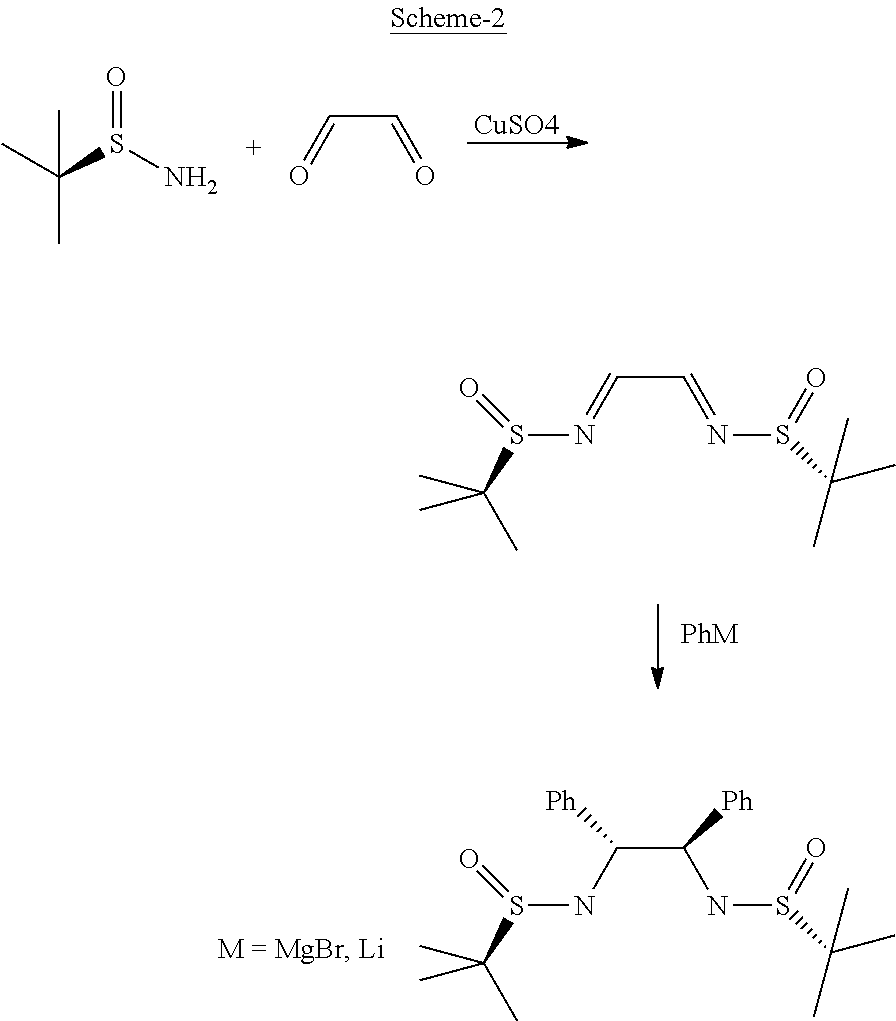Process for diastereoselective synthesis of vicinal diamines
a technology of vicinal diamine and synthesis process, which is applied in the field of process for the preparation of diastereoselective synthesis of vicinal diamine, can solve the problem of high efficiency of asymmetric synthesis of enantiopure vicinal diamine, and remain significant synthetic challenges
- Summary
- Abstract
- Description
- Claims
- Application Information
AI Technical Summary
Benefits of technology
Problems solved by technology
Method used
Image
Examples
example 1
(R)-N-((1R,2S)-2-((diphenylmethylene)amino)-1,2-diphenylethyl)-2-methylpropane-2-sulfinamide (1a)
[0058]
[0059]Obtained 1a as a white solid (350 mg, 76%) according to the general experimental procedure as described above using N-tert-butanesulfinyl aldimine (RS) 5a (200 mg, 0.95 mmol), Ketimine 2a (1.91 mmol) and LiHMDS (1.0 M in THF, 1.72 mmol).
[0060]Melting point=120-122° C., [α]D25=108.57 (c. 0.25, CHCl3),
[0061]1H-NMR: (400 MHz, DMSO-d6) δ 7.62 (d, J=7.2 Hz, 2H), 7.47-7.17 (m, 18H), 6.35 (d, J=7.2 Hz, 2H), 5.34 (d, J=10.0 Hz, 1H), 4.76 (dd, J=9.6, 4.0 Hz, 1H), 4.57 (d, J=4.0 Hz, 1H), 0.90 (s. 9H). 13C NMR (100 MHz, DMSO-d6) δ ppm: 168.6, 142.3, 139.2, 136.0, 130.8, 128.8, 128.6, 128.4, 128.2, 128.0, 127.6, 127.3, 127.2, 127.0, 71.3, 66.9, 56.2, 22.5.
example 2
(R)-N-((1R,2S)-2-((diphenylmethylene)amino)-1-(4-methoxyphenyl)-2-phenylethyl)-2-methylpropane-2-sulfinamide (1b)
[0062]
[0063]Obtained 1b as an off-white solid (320 mg, 75%) according to the general experimental procedure as described above using N-tert-butanesulfinyl aldimine (RS) 5b (200 mg, 0.83 mmol), Ketimine 2a (1.67 mmol) and LiHMDS (1.0 M in THF, 1.5 mmol).
[0064]Melting Point=56-58° C., [α]D25=59.53 (c. 0.25, CHCl3)
[0065]1H-NMR: (400 MHz, DMSO-d6) δ 7.62-7.15 (m, 15H), 6.77 (d, J=8.4 Hz, 2H), 6.45 (d, J=7.2 Hz, 2H), 5.23 (d, J=9.6 HZ, 1H), 4.70 (dd, J=9.2, 4.4 HZ, 1H), 4.54 (d, J=4.4 Hz, 1H) 3.70 (s, 3H), 0.9 (s, 9H).
[0066]13C NMR (100 MHz, DMSO-d6) δ ppm: 168.4, 158.6, 142.4, 139.3, 136.1, 134.3, 130.8, 130.1, 129.3, 128.9, 128.7, 128.6, 128.3, 127.7, 127.2, 113.4, 71.5, 66.5, 56.1, 55.5, 22.5.
example 3
(R)-N-((1S,2S)-2-(4-chlorophenyl)-2-((diphenylmethylene)amino)-1-(furan-2-yl)ethyl)-2-methylpropane-2-sulfinamide (1g)
[0067]
[0068]Obtained 1g as an off-white solid (450 mg, 90%) according to the general experimental procedure as described above using N-tert-butanesulfinyl aldimine (RS) 5c (200 mg, 0.99 mmol), Ketimine 1b (1.98 mmol) and LiHMDS (1.0 M in THF, 1.78 mmol).
[0069]Melting Point=110-112° C., [α]D25=66.49 (c. 0.25, CHCl3),
[0070]1H-NMR: (400 MHz, DMSO-d6) δ 7.64 (d, J=7.2 Hz, 2H), 7.50-7.40 (m, 8H), 7.33 (d, J=8.4 Hz, 2H), 7.22 (d, J=8.4 Hz, 2H), 6.74 (d, J=5.6 Hz, 2H), 6.33 (s, 1H), 5.12 (d, J=9.6 Hz, 1H), 4.58 (d, J=5.2 Hz, 1H), 0.93 (s, 9H).
[0071]13C NMR (100 MHz, DMSO-d6) δ ppm: 168.7, 143.1, 141.3, 140.7, 139.3, 136.1, 131.7, 130.9, 129.7, 129.1, 128.9, 128.7, 128.7, 128.4, 127.3, 126.8, 110.7, 70.1, 59.5, 56.1, 40.6, 40.4, 40.2, 39.9, 39.7, 39.5, 39.3, 22.6.
PUM
| Property | Measurement | Unit |
|---|---|---|
| temperature | aaaaa | aaaaa |
| temperature | aaaaa | aaaaa |
| solvent | aaaaa | aaaaa |
Abstract
Description
Claims
Application Information
 Login to View More
Login to View More - R&D
- Intellectual Property
- Life Sciences
- Materials
- Tech Scout
- Unparalleled Data Quality
- Higher Quality Content
- 60% Fewer Hallucinations
Browse by: Latest US Patents, China's latest patents, Technical Efficacy Thesaurus, Application Domain, Technology Topic, Popular Technical Reports.
© 2025 PatSnap. All rights reserved.Legal|Privacy policy|Modern Slavery Act Transparency Statement|Sitemap|About US| Contact US: help@patsnap.com



